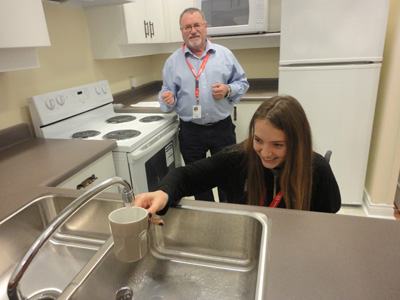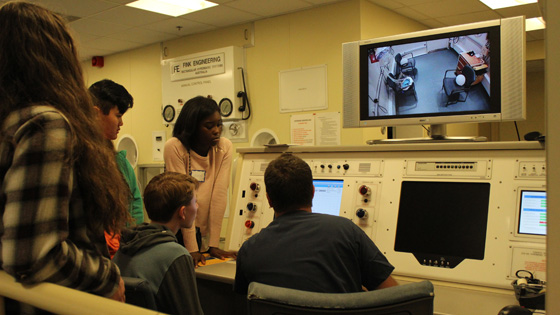
Grade 9 student Emma (R) breathes using a ventilator in respiratory therapy in the intensive care unit at Toronto Western Hospital during Take Our Kids to Work Day Wednesday under the watchful eye of fellow student Vishvak and Angela McGauley (L) Respiratory Therapist Practice Leader. (Photo: UHN)
It was a day as rich in experience and diverse in activity as UHN itself.
The 2015 version of UHN Take Our Kids to Work Day saw more than 200 Grade 9 students – children of employees – spend time in clinical and research departments across all four hospitals to get a feel for what happens here each day.
The students spent the day at one hospital, moving around to many different areas.
"It's a lot of different activities that get you involved," said Liam, a student who spent the day at Toronto Western Hospital. "I didn't know we'd be doing so much hands-on stuff. I like that."
From understanding how to use a defibrillator or trying out different equipment in a rehab gym, to learning about different food textures and the packaging of medications, the day was designed to give students a glimpse into healthcare professions, the use of state-of-the-art technology in patient care and cutting edge research done at UHN.
Take Our Kids to Work was founded in 1994 by The Learning Partnership, a national charitable organization promoting and supporting publicly-funded education in Canada. It began in the Greater Toronto Area but now spans the country and happens in November every year.
It began at UHN under the leadership of Emma Pavlov as a corporate initiative in 2006.
"My hope each year is that Grade 9 sons and daughters of UHN staff gain a bit more insight into their parents' workplace, become aware of the diversity of professions within healthcare as they contemplate their own future careers, and leave the day excited and inspired by some of the amazing work being done at UHN," says Emma, Executive Vice-President, Human Resources and Organizational Development.
Organized by Volunteer Resources with the assistance of clinical, research, and human resources staff across UHN, the day began similarly for all students with an introduction and orientation.

In Toronto Rehab's HomeLab, Dr. Don Philip asks student Megi to attempt to get water from a typical sink while in a wheelchair. (Photo: UHN)
From there, the Grade 9s visited various areas of their hospital. Clinical and research staff took time out of their busy schedules to teach, inspire and excite a new generation of kids about healthcare and how various professions make a positive impact on the lives of patients.
Through hands-on activities, demonstrations, presentations, simulations, video, role playing and discussion with clinical and research staff, the students got a sense of the diversity of healthcare as well as the many exciting roles and responsibilities of its professionals.
Each site offered different glimpses into a day at UHN. Here are some snapshots:
At Toronto Rehab, students learned about the strong impact advances in technology have on rehabilitation and the overall treatment of patients.
They had the opportunity to test their response rate just like elite athletes, participate in therapeutic recreation, tour through the iDAPT Centre for Rehabilitation Research, learn how to make a splint and see first-hand the miracles that are performed in the lives of rehab patients.
"It was fun," Michelle said after a tour of HomeLab and iDAPT. "It was cool to see all the simulation labs. I really wanted to try them."
Francesca visits the Look Good Feel Better Wig Salon at the Princess Margaret. She's excited to take part in Take Our Kids to Work Day to learn more about what her mother, who works with chemo patients, does at the cancer centre. (Photo: UHN)
Princess Margaret Cancer Centre students learned about the breadth of the cancer programs available to patients – both clinical and supportive. They were also taught about cancer treatments such as radiation and chemotherapy.
The Grade 9s also visited unique areas such as the Look Good Feel Better Wig Salon, the Image Guided Therapy Lab, Eye and Facial Prosthetics, Dental Oncology. At ELLICSR: Health, Wellness and Cancer Survivorship Centre, they saw a nutritional cooking demonstration by Chef Geremy Capone.
For Mayank, an aspiring oncologist, Princess Margaret is the perfect place to learn more.
"I don't really like math," Mayank says. "But I'm good with science."

Matt Dodds (R) respiratory therapist in the Hyperbaric Medicine Unit, lets the visiting Grade 9 students take over the controls of a hyperbaric chamber. (Photo: UHN)
At Toronto General Hospital, some students learned about transplantation while others visited the Laboratory Medicine Program, rotating through Surgical Pathology, Immunohematology and Core Lab. Some spent time with Nursing, Pharmacy, Medical Engineering, Human Factors, SIMS, Central Processing, Transplant, Respiratory Therapy, Research, and Medical Imaging.
With Nursing, they discussed bullying and learned how to use a defibrillator. In Respiratory Therapy, they learned how to intubate a patient. While in Pharmacy they saw how medications were packaged and creams were made.
In Central Processing, students learned about the different modes of sterilization for instruments used in the Operating Room while in the Hyperbaric Chamber they learned about hyperbaric oxygen therapy.
In Medical Imaging, Medical Engineering and Human Factors, they learned about biomedical devices, imaging technology and the positive impact of technology on healthcare.
At Toronto Western Hospital, students who visited Pharmacy also learned how to package medications and create creams while those who went to the Musculoskeletal Health and Arthritis Program and Hand Program had the opportunity to make splints and casts as well as view computer simulations.
Students who visited the OR at TWH participated in a laparoscopic simulation, practiced suturing and learned about anatomy while those who spent time with the Community and Mental Health Program visited an addictions centre.
Students who visited Nuclear Cardiology saw images of a heart pre and post a heart attack while others who visited Neuro-psychology saw and discussed the effects on a patient who underwent deep brain stimulation. Allied Health taught students about the different equipment in a rehab gym, about different food textures, nutrition, and about the various allied health professions.
In Medical Imaging and Medical Engineering, students learned about and used various biomedical devices and discovered the amazing world of imaging technology.
Staff in research at both TGH and TWH provided the students with insights on computer simulations, medicinal chemistry, computational neuroscience, NMR Spectroscopy and imaging, and discussed traditional/non-traditional science careers.
